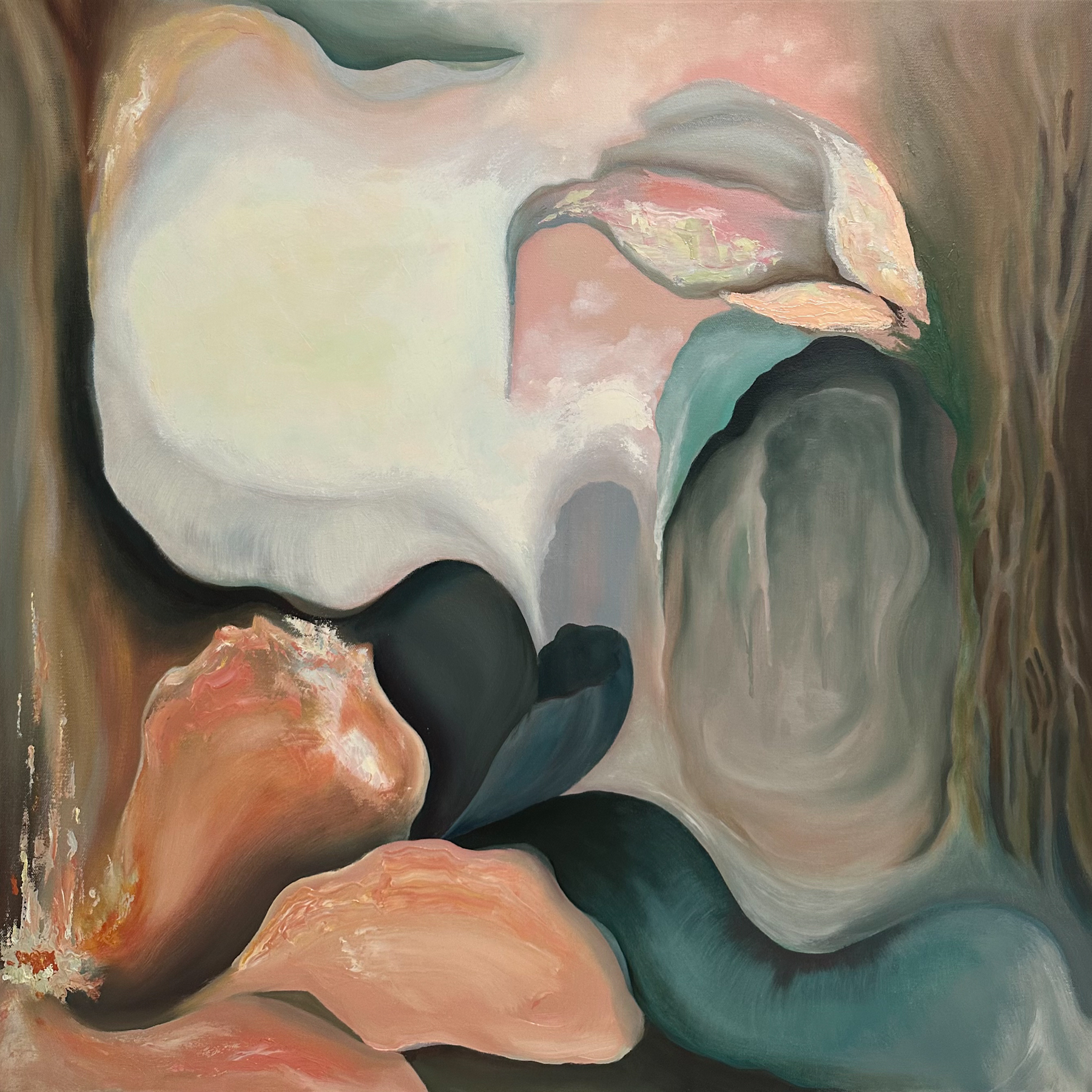This August, Indonesian-born, Jerusalem-based artist Betty Susiarjo showcases Hening: A solo exhibition featuring twelve mixed-media works ranging from works on paper (using Washi stickers), videos to a wall-installations at CGartspace in Jakarta. Curated by Heru Hikayat, Hening attempts to embody the space between artist and material, and the geographical distance from Susiarjo to her homeland. In the realm of man-made borders and a quest for quietude, Susiarjo blends movement and stillness coexisting in delicate contrast.
Concurrently, Filipino-born, Singapore-based artist John Marie Andrada contributes four new works at Haridas Contemporary in Singapore. As part of Singapore Gallery Month 2025, the exhibition Small Things Brought Together offers the works of nine emerging and mid-career artists as a preview of the gallery’s programming for 2025/26. Andrada’s participation in the group show commemorates Haridas Contemporary’s move to Tanjong Pagar Distripark, marking the gallery’s efforts to cultivate their roster of regional and Singapore-based artists. Andrada’s paintings form the basis of her expanding Undergrowth series, wherein elements of nature become interwoven metaphors for physical sanctuary, desire and growth.
Writer Euginia Tan speaks with Susiarjo and Andrada on their creation process and the significance of their respective shows on their practices. In this conversation, we learn how their resulting works are borne from experiences of grief and hope, amidst breaths and borders.
Euginia Tan (ET): Hi Betty and Marie! Congratulations to the both of you on your respective shows. First off, let’s get an introduction from each of you regarding your practices, and where your interests lie.
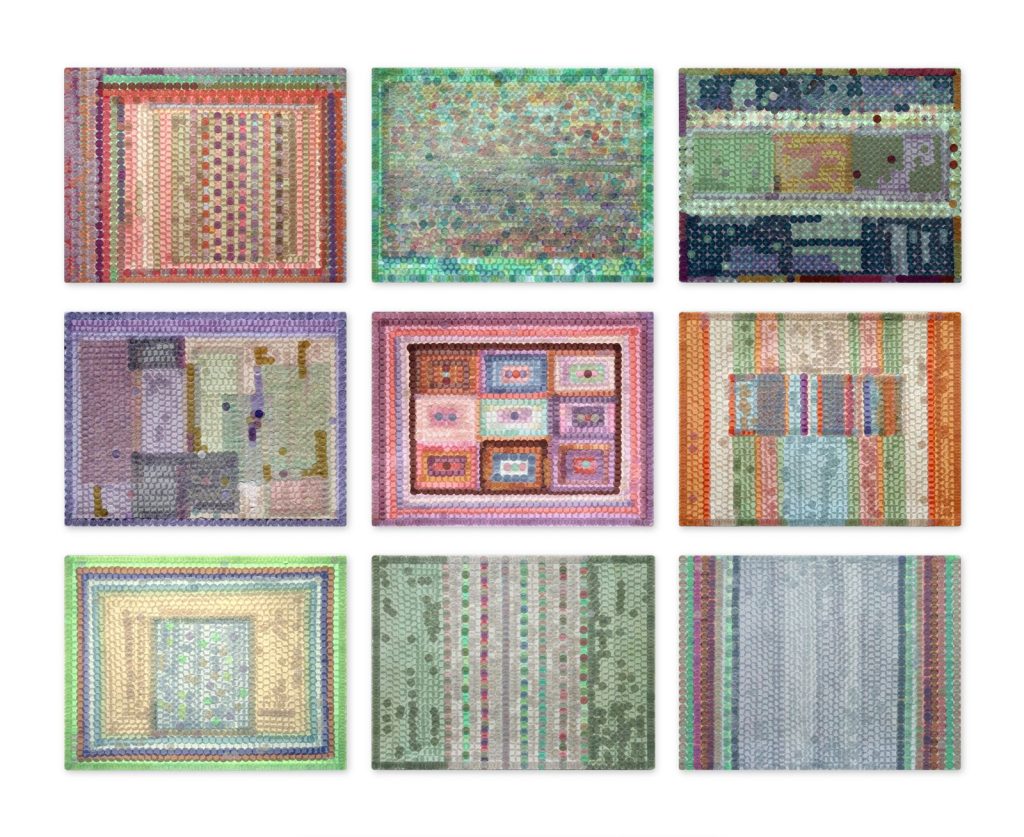
Betty Susiarjo, Evenings (2024-2025), Washi stickers on paper
Betty Susiarjo (B): This solo is a restart for me. I have not been producing works since I became a mother, and my time was intentionally dedicated to my young children. Before this solo show, I have participated in group shows. I enjoy group shows because I get to see my works in varying perspectives with others, many of whom are younger than me: Like Marie’s age! But a solo show is important for me because I can see where my practice is at present, in relation to where I was. When my works are presented in the gallery, I have a clarity of where my practice is currently.
John Marie Andrada (JM): I do echo that solo shows help you see where you are in your practice. I had my first solo last year. For that show, there were image manipulations in the form of video, and paintings. Back in school, I started with oil paintings before I went into photography and video. I realized the way I manipulate image has a painterly quality. So, I’ve been exploring more with painting as a medium and how to expand that.
Right now, my works are a cross between figurative and abstract form. The new Undergrowth series started from an image work I was exploring. Compared to my first solo Breadth of Air, which revolved around grief and absence/presence, questioning identity and home. When I started Breadth of Air‘s topics of grief, I used different mediums (to commemorate) my late grandmother. It turned into a statement of the persevering qualities in love. My practice continues with different ways of manipulating images with inks and testing the limitations of what an image can hold.

John Marie Andrada, In Spring (2024), Oil on canvas
ET: In both your practices, I hear an ongoing journey. Both of you are also practicing away from your countries of birth. Could you describe how you have come to track this internal and external commute emotionally and visually?
B: When I moved to Jerusalem, I started contemplating notions of invisibility, or the unseen. I’m an Indonesian citizen, and both Israel and Indonesia do not have a bilateral relationship. There’s no Indonesian embassy in Israel. I’ve never been in a place where there is no representation or governing body for my country of origin.
With that, I feel like there is an invisibility I am experiencing, because I have limited knowledge of the language and culture in Israel. On the other hand, I’m no longer part of the society I call home in Indonesia, though also not fully assimilated at my current place of residence.
As I’m in this state of wandering, my work emphasizes that transient quality of staying unseen. It’s not trying to hide, but it’s also not being vocal. Whether it is from fear, or uncertainty, or simply the difficulty of explaining the truth.
Very often, what appears in front of us may not be reality. What is unseen may hold more truth. I started to question immediate things that appeared in front of me- for example, social media. That made me realize information can be so easily accessed, but it may not always be accurate.
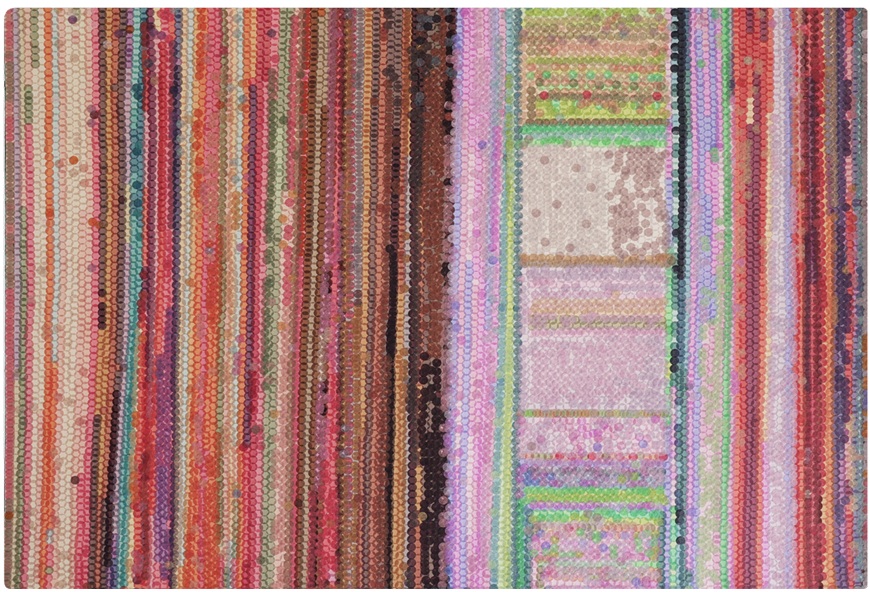
Betty Susiarjo, Earthlight (2024), Washi stickers on paper
JM: For me, I grew up in the Philippines where we had a backyard. Moving to Singapore into a HDB home, there was an estrangement with nature. That influenced my new series which uses our closeness with nature as a vantage point to internal landscapes. I’ve been trying to address and reconcile the gaps of being invisible too (which Betty mentioned). With my paintings, I try to bring up a presence in the absence that is felt in certain situations.
Parts of our human body remind me of the elements of nature. For example, caves may look like our ears, our veins can look like roots, vice versa. I’ve tried to incorporate such imagery into my work and pondering what is real also intrigues me. Materially, I attempt to make images more tangible than they are perceived to be.
My paintings are intuitive in movement. The making process is hands on, what you leave on your canvas is a residue of your thoughts. In that way, there is a kind of transfer akin to moving to different places in the world. Where you go to or reside will influence and evolve your practice. Ironically, sometimes being away brings you closer to home.
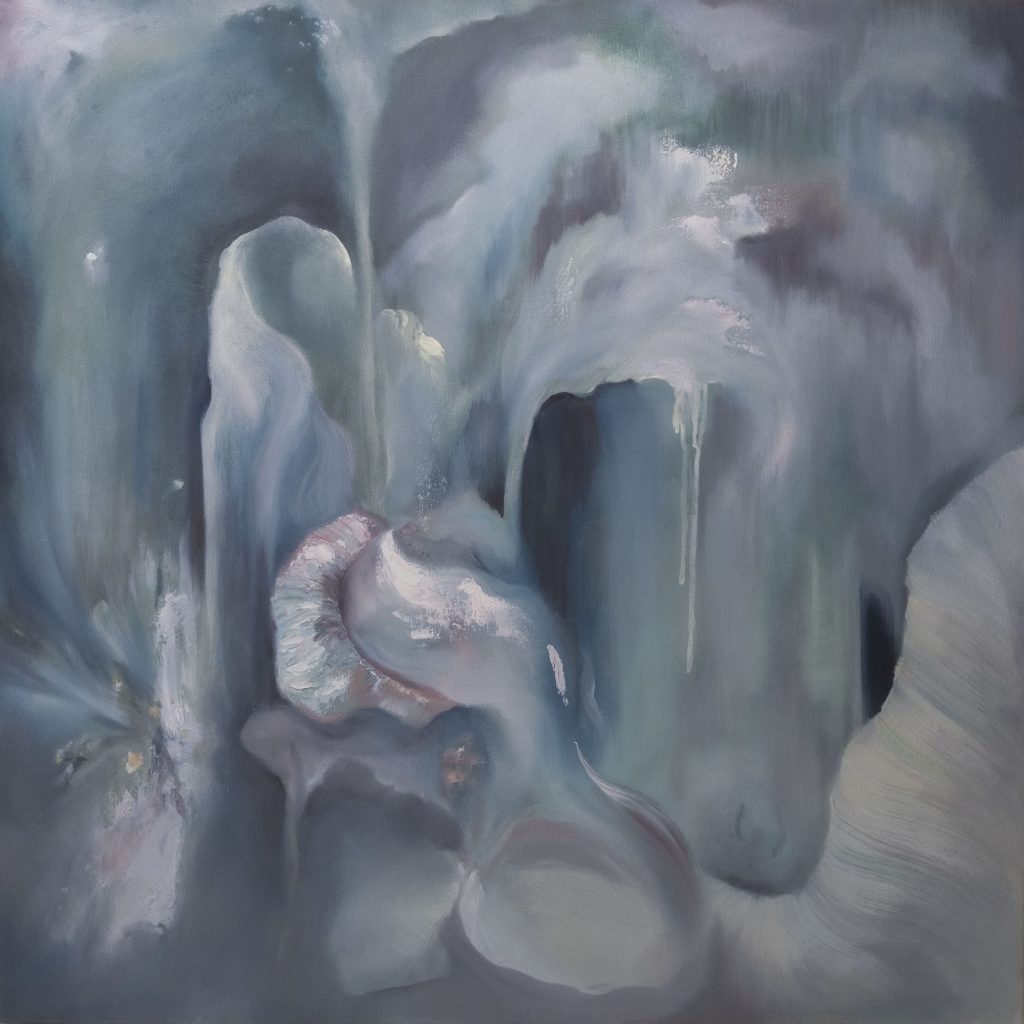
John Marie Andrada, Reprise (2024), Oil on canvas.
E: I appreciate how both of you describe your processes with identity, transfer and liminal possibilities in migration and artmaking. In all your works demonstrating surface manipulation, whether it is via painting, video work, object installation: Could both of you explain how you perceive surfaces and what it means to include and manoeuvre them to your surroundings?
JM: When I first learnt about painting, it was taught as something two-dimensional. As I refer more to it, it encompasses other dimensions via the colours and compositions on the canvas. With sculptures- There is a lot to think of in their layers, even digitally. Everything is dynamic when you can see this connection through various mediums. This connection can be translated from one form to another. For me, surfaces are a way to describe a plane. From there, there are infinite ways to play around and interpret it.
For an everyday object, if you remove their context -for example in Betty’s washi sticker series- The stickers become another conduit depending on how you piece them together. There exists a tactility which screens cannot convey, in today’s conditions.
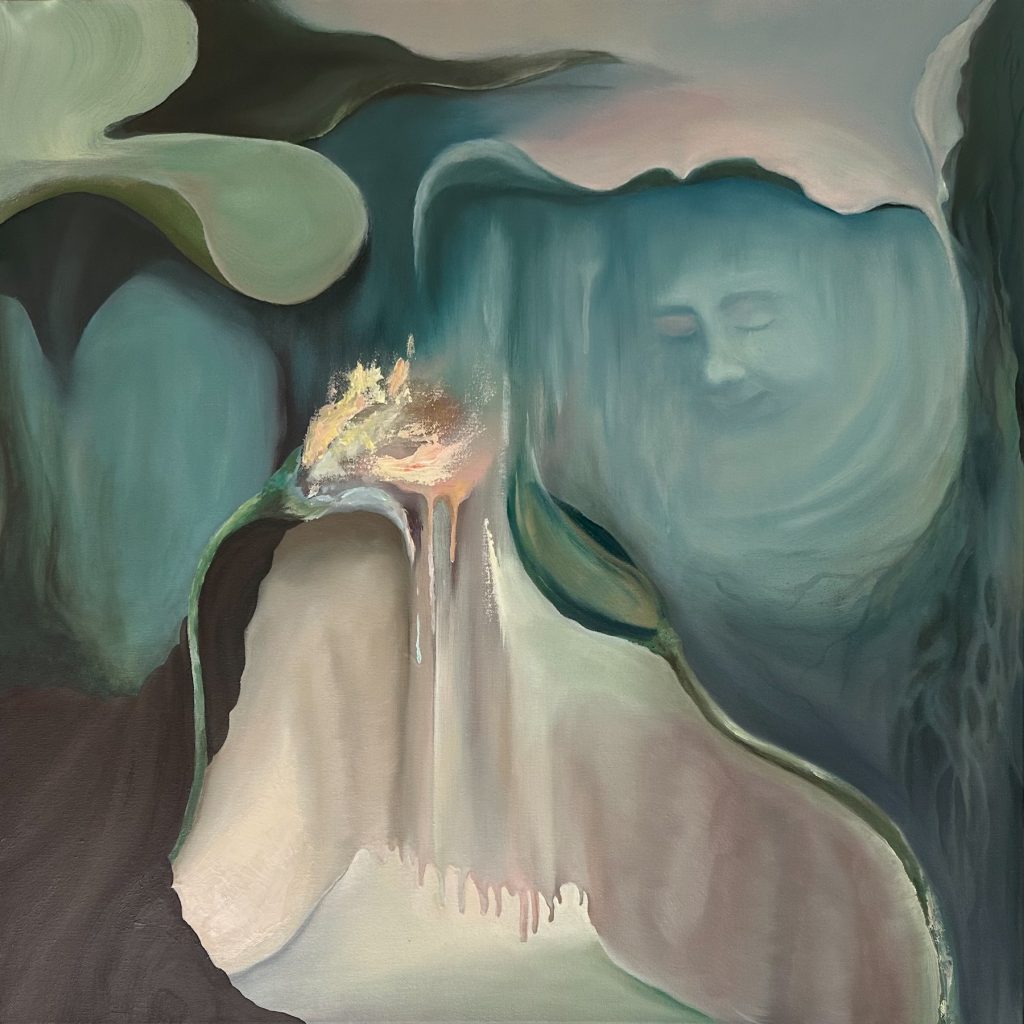
John Marie Andrada, Winter Spring (2025), Oil on canvas.
B: We live in a world surrounded by items and materials. From stationery, to toys, to industrial objects… All these objects excite and stir possibility. There is a desire from our hands to interact, touch and make something out of them. For example, in my work The Consistency of Flow, I use thread and nails on the wall. This work was created when I was a student, and I was testing stitches on paper.
I thought this could be transferred to a wall, wherein the wall is the paper. The threads were then fixed with nails. Now, this work is relevant to me again. In response to Marie’s observation, I do feel our innate tactility is heightened too, especially across the generations we were born in, where we witness the production of goods at its peak. As we are exposed to materials, we naturally become curious about their surfaces.
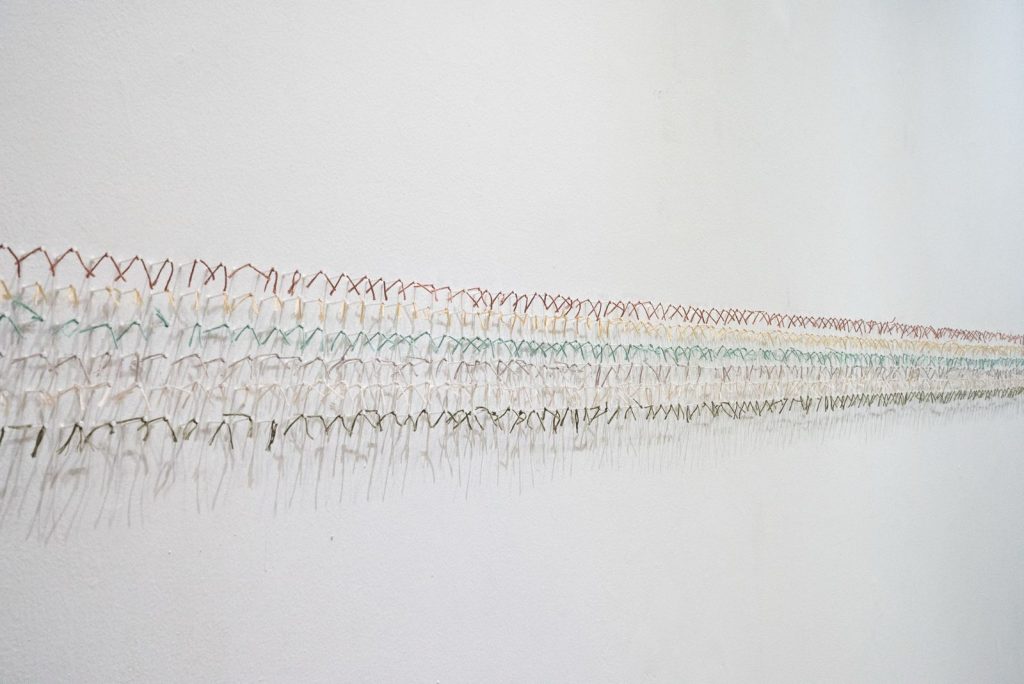
Betty Susiarjo, The Consistency of Flow (2025), Nail and thread on wall
ET: I’d like to delve into the titles of your respective series Undergrowth (by John Marie) and Hening (by Betty Susiarjo). What drew you both to these titles and their definitions for each of you?
B: For Hening, the curator selected this title based on his reading of departure and returning in my works. Initially, he suggested that there may be some longing for home. Home as comfort, rather than a physical home.
I do agree that I am yearning for quietude and silence. In the repetition of my making process, I find some solace from everyday life. It made me question what it meant for me to make art. I realize artmaking is carving space and time for oneself, to dispense full attention into something not quite there yet. The art is becoming, and we have to be there for it.
This roots me because the nature of our attention is fragile. As we become immersed in our practice, we realize the significance of attention we grant to our work. This attention is also an experience of beauty.
In our daily lives, our attention is constantly broken down. For now, we are conversing. Soon, I’ll have to get back to the gallery or the kids. Hening represents a purposeful silence, by choice.

Betty Susiarjo, A Dazzling Grey (2019), Video
JM: The fact that Hening doesn’t have a direct translation is poetic in itself! I can’t agree more that attention and time is crucial to your practice. I can’t create when I’m angry, or if there is too much noise. The setting of a space needs to be conducive because when we’re creating, it’s an intuitive process. You need attention to sense the next step.
I chose Undergrowth as my series title to describe the undergrowth of a forest. There is a network below we can’t see, as things grow. Since our bodies are composed of water, there is a resonance with how fluid our emotions are. We constantly change between states. Undergrowth represents something that is always shifting, even if we don’t see it at first sight.
I’m trying to draw comparisons from our body parts and earthly elements. I’d like for it to be a reminder that we are not too separate from nature. At the same time, the works serve as imaginary landscapes. While I incorporate the portrayal of actual flora and fauna, they are suggested rather than affirmed.
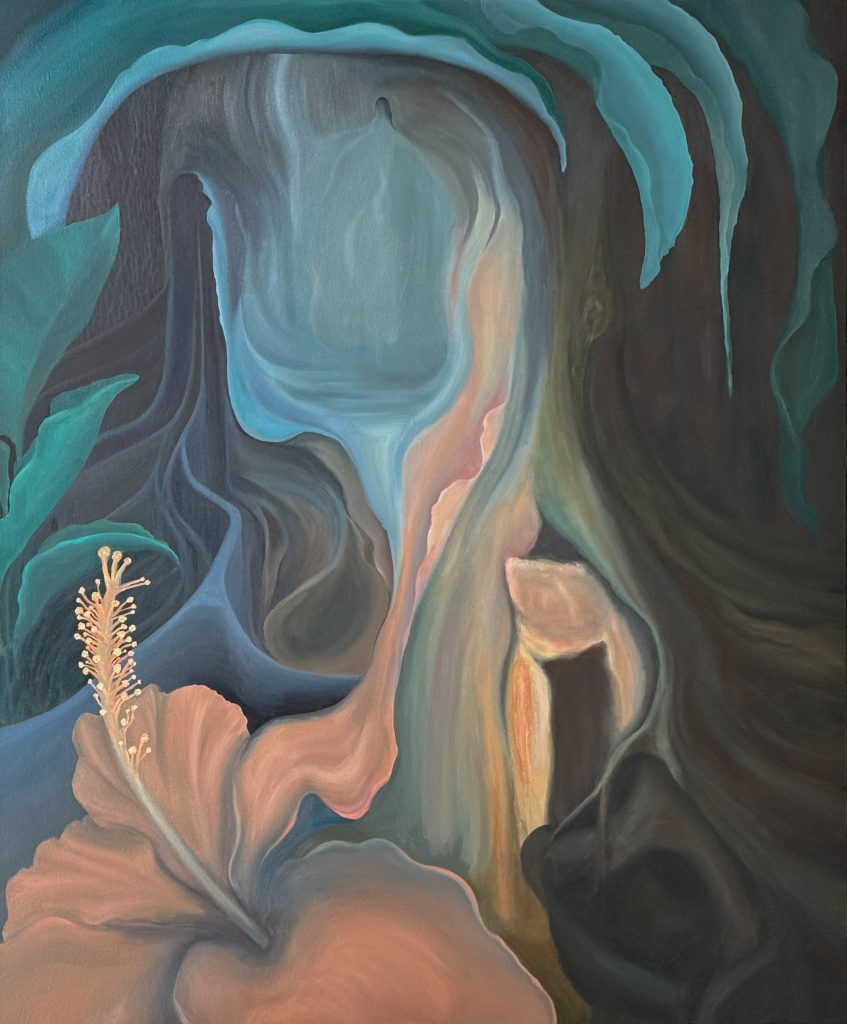
John Marie Andrada, Beyond the Tree’s Hollow (2025), Oil on canvas
B: Some titles of works came to me because I live in the desert. The desert is not a landscape I am familiar with; I grew up in tropical countries where colours are vivid and lush. In the desert, it is mostly ochre. However, the more I familiarized myself with the desert landscape, the more I began to see colours. If you look carefully, there are small signs of life. The sunset against the sky is dramatic.
Living in the desert inspires me and taught me what is essential. Many items become distractions. Our possessions become ‘too much’ when they are brought to the desert. This changed how I viewed things, from my practice to the interior of my house. I think the desert is a turning point for artists. If I personify getting to know the desert, I will describe this person as cold and reserved. They can be hard to like at first. But the desert also has a feminine quality, amidst the sand and rocks. My heart unfurls in the desert.

Betty Susiarjo, The Scent of Rain on Sand (2025), Washi stickers on paper.
JM: For me, the obscurity of the undergrowth compels me. People are like trees. We grow and go through seasons. To draw parallels to the undergrowth, we never fully know what a person goes through, just as how the undergrowth never reveals itself but keeps thriving.
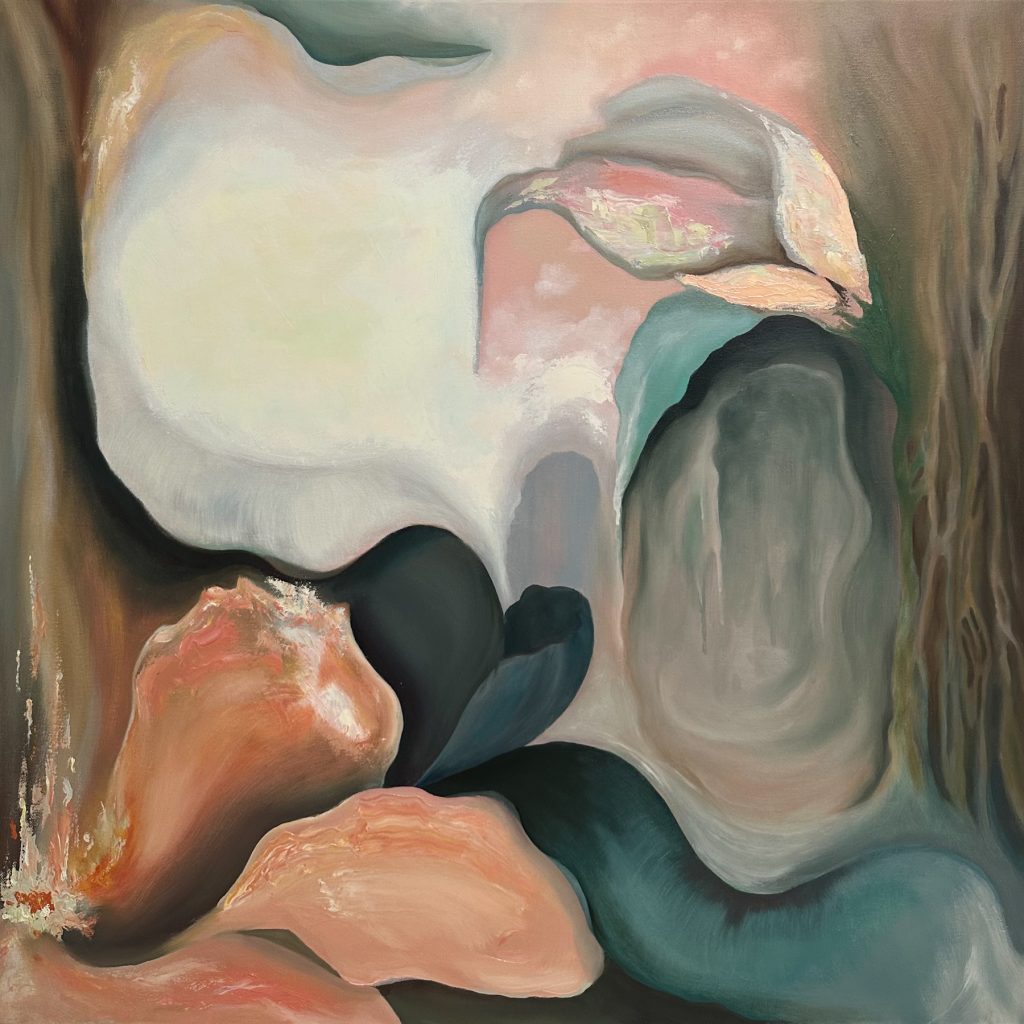
John Marie Andrada, In Bloom (2025), Oil on canvas
ET: Thank you for your time with me today! For my last question: As active artists from different generations, how does it feel to meet at intersections with your works?
B: This must be encouraged! There is a lack of conversation generally, between artists (of different generations). We are asked often of our individual practices, but it is also fun to hear another perspective and viewpoint. This informs me of how artmaking practices respond to time. Certain things come and go, while some sustain. I would love more of these encounters to happen, across continents and cultures.
JM: While artists come from different walks of life, the common thread of artmaking is enough to bind us. In these exchanges, we experience glimpses of our thoughts and routines. There is only so much we can emphasize on as individuals. These conversations help us feel connected, enriched and hopefully reach into other depths of our practices.
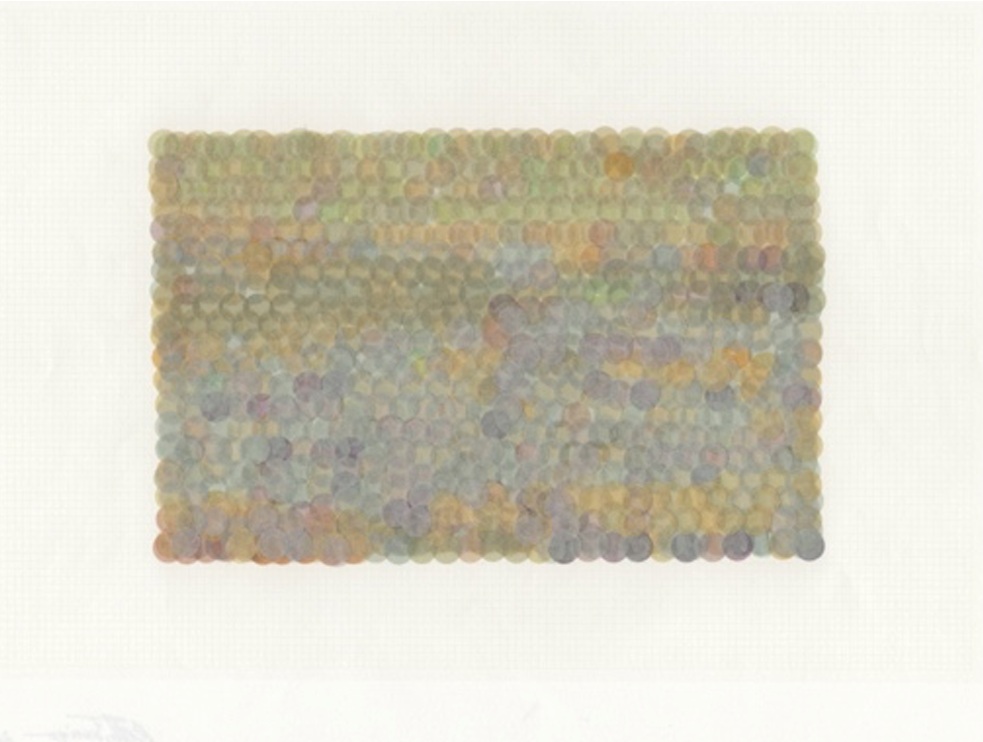
Betty Susiarjo, Concrete Poetry (2024), Washi stickers on paper.
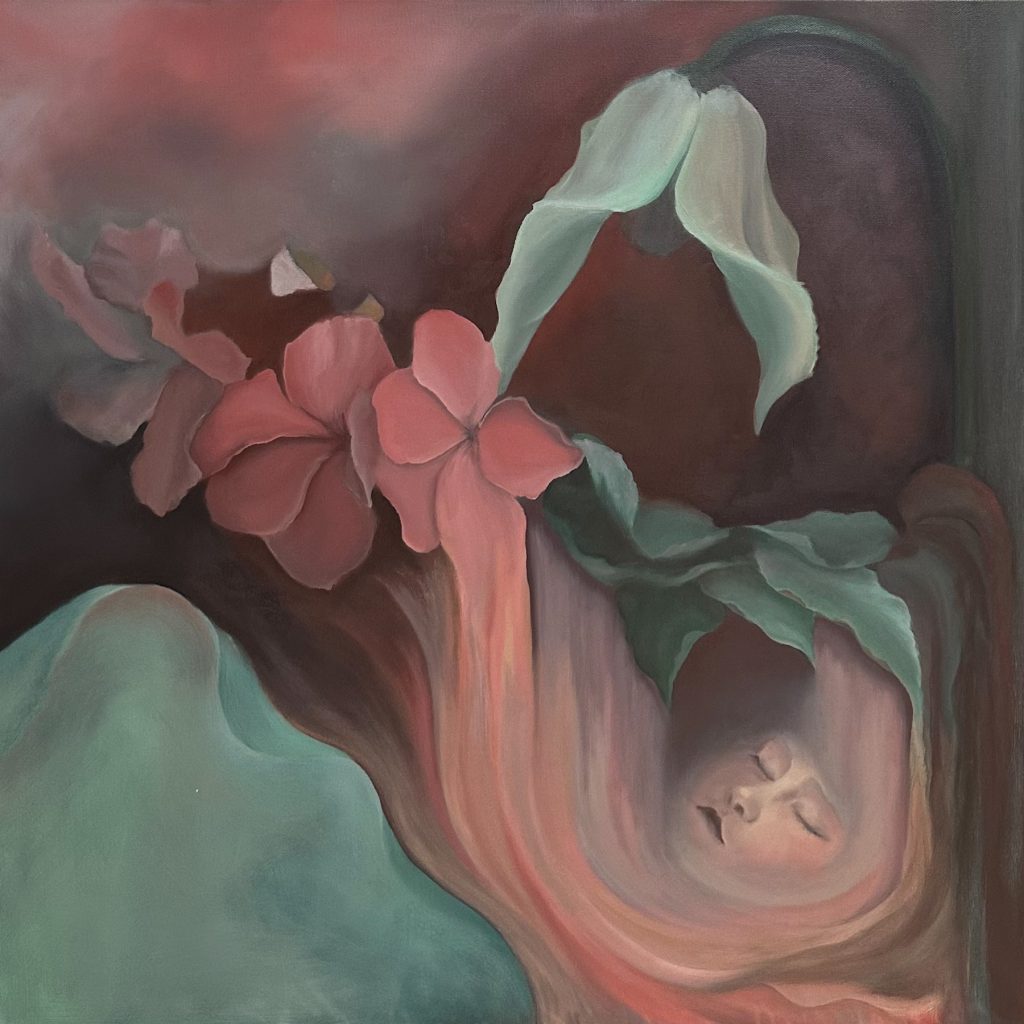
John Marie Andrada, Autumn Fall (2025), Oil on Canvas
ARTIST BIOS
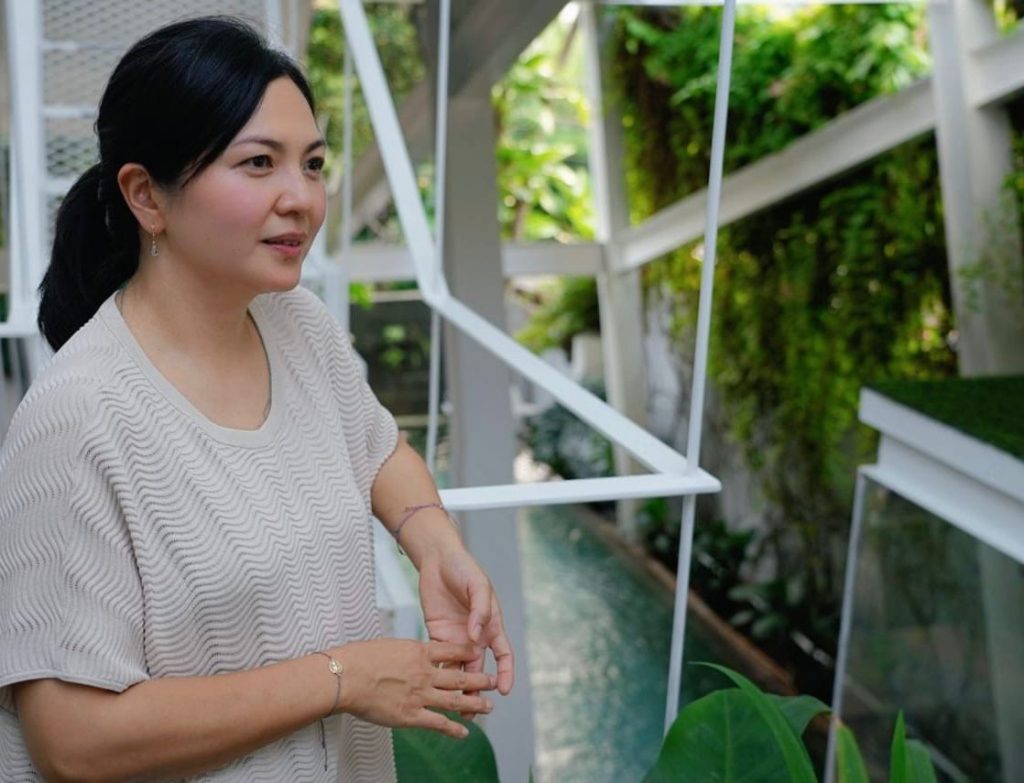
Betty Susiarjo (b. 1980) is a mixed-media artist whose work engages concepts of temporality, materiality and sublimity. She received her MA (Fine Arts) with Distinction from Winchester School of Art, England and her BA (Fine Arts) from Surrey Institute of Arts and Design, England.
Influenced by the studies of physics and metaphysics, her work seeks for an awareness of a moment presented in a particular time and space, thus providing a poetic realm for contemplation. In recent years, her research has inclined towards the study of light, shadow and the unseen and how their qualities affect our experience and encounter with beauty. Employing some element of craft to her work, she juxtaposes methods such as sewing, embroidery, beading etc. to create visual sensations that lie between the perceptible and the illusioned.
In 2016, her work has been shown at Motions, a multi-media exhibition in OTA Fine Arts, Singapore and Tokyo, Japan; as well as A Dazzling Grey, an artist residency in Fukuoka, Japan. In 2017, she was a participating artist Changing Perspectives in ARTJOG 10, Yogyakarta, Indonesia; and created The Blue Who Swims All This Way for an exhibition at The National Gallery, Singapore. In 2019, she participated in Personal Structures: Identities, hosted by the European Cultural Centre, in the context of Venice Biennale, Italy.
Hening runs till 31 August 2025 at CG Artspace, Jakarta (https://www.instagram.com/cgartspace/).
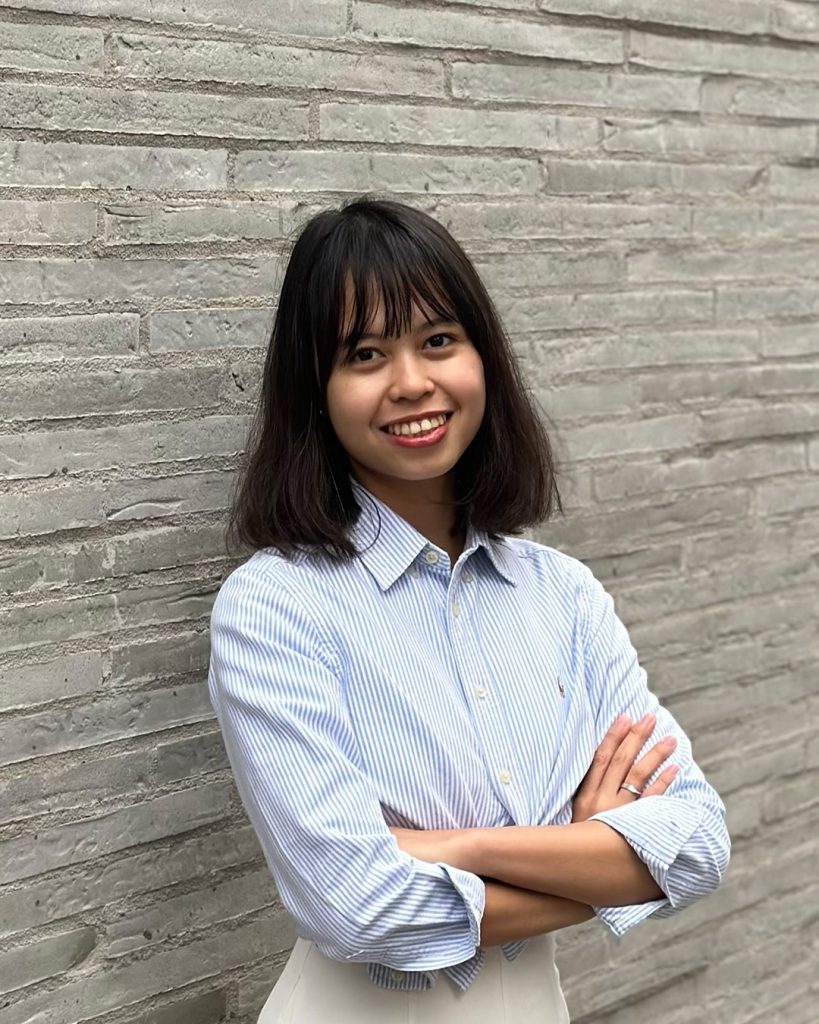
John Marie Andrada (b. 2001, Philippines) is a multidisciplinary artist based in Singapore whose work spans painting, installation, sculpture, photography and video. Growing up and taking root in a once foreign country, she moves between mediums, drawing from personal recounts to reflect on the complexities of identity, time and the human experience. Defined by an ongoing investigation of how narrative and visual language can intertwine, her practice blends figuration and abstraction, driven by an intuitive, experimental approach to image-making. Andrada graduated with a Bachelor in Fine Arts (First Class Honours) from LASALLE College of the Arts in partnership with Goldsmiths, University of London in 2023. In 2024, she debuted her first Solo with Haridas Contemporary, Singapore. She was a recipient of The Winston Oh Travelogue Award (2023) and the 41st Daegu International Grand Exhibition Special Choice Award, Korea (2022). Her works have also been featured in Japan, Istanbul and China.
Small Things Brought Together runs till 31 August 2025 at Haridas Contemporary, Singapore (https://haridascontemporary.com/exhibition/small-things-brought-together/).
WRITER BIO
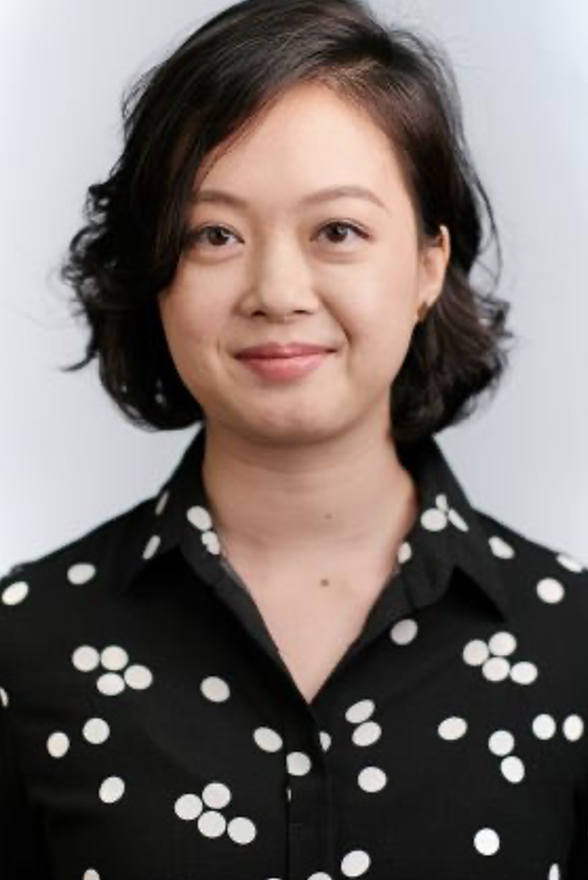
Euginia Tan is a multi-disciplinary writer based in Singapore. She has experience in an array of written forms including poetry, prose and playwriting. She has written curatorial essays for visual artists such as Melissa Tan, Hu Qiren and Faris Nakamura, to name a few. Euginia’s analysis explores and covers contemporary practices, their range of mediums as well as her personal take on creating conditions in Singapore and Southeast Asia, and its various impacts on artists.
